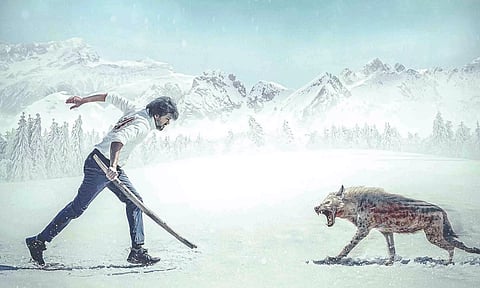

CHENNAI: The 1979-Rajinikanth blockbuster, Annai Oru Aalayam starts-off with a ruthless hunting sequence followed by a conversation between Vijay (Rajini) and his mother, where she advises her son to go easy on animals and adds that animals too possess maternal instinct and all other human emotions.
Cut to 2021, a deja-vu occurs when the titular Kaadan (Rana Daggubati) in his monologue on how elephants too have families, love, fear and affection like humans. The recent Deepavali release Jigarthanda DoubleX too explores the same paradigm, with a different premise.
With a sizable number of his films set in the wilderness, director Prabu Solomon, who in a way set a trend with Kumki (2012), says with authority that elephants are well-behaved as long as their needs are met. “Provide the elephants with the right amount of heat, food, shelter and isolation (when necessary), they are very friendly,” he says. Prabu adds that the jumbos are choosy in their interaction with humans, “I used to feed Manickam (Kumki) vellam (jaggery) every morning and it eatas from me sensing my joviality, whereas another person’s bid to feed Manickam failed since he displayed fear.” He fondly tells us that Manickam still remembers him.
The reflection of human’s traits in a tusker worked big time in Kumki and Kaadan. The audience may even dissociate with humans on-screen when animals offer catharsis as drama unfolds, which explains why we don’t get to watch a Marley & Me kind of film often. However, Rakshit Shetty charted a course defying the hero-centric industry with 777 Charlie.
“The animal gets the love and attention first, the actor only comes next. It is purely a personal call of a star to agree to this proposition,” Rakshit tells us what is expected from an actor in films driven by animals. Talking of the chops an actor needs to possess, Rakshit tells when there are two human actors there is a “give and take” but when there is a human and an animal there is no reciprocation since the animal may seem to respond to a human on-screen, but in real it only does what it has been trained for.
The unpredictability of an animal may give an impression that technology is a safe alternative. But the catch is, if CG goes wrong there would be a backlash, accompanied by a loss of several crores. If it clicks, the artificially-generated animal would stand out even in a film of larger-than-life stars like Vijay (Hyena in Leo). Santosh, a compositing artist, takes us through the processes that go into bringing artificiality close to reality.
“There are several departments involved in creating an animal in CG. The director approaches to create an animal with specifications. After running an R&D about the animal’s mannerisms a modeller creates a 3D animal and it is sent to the rigging team upon getting approval for the model,” says Santosh. He averred that rigging is what makes or mars the CG process as it deals with the movements of an animal and the way it reacts on coming in contact with humans. “Then comes my department, the Compositing department, the final out goes from us. We are the ones who merge animals with the scene and blend it with lighting patterns to make it look realistic,” Santosh adds, saying the deadline is a challenge, but the process is exciting.